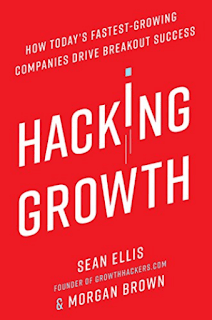The psychology of influence and hacking growth
Post originally posted on waynehaber.com
I finished two books recently on the related topics of hacking growth and the psychology of influence.
My notes and excerpts are below. They surely do not do the books justice as the books include essential details and great stories about these concepts in action. They also discuss how to influence others (with good intentions or bad intentions). The influence book also includes recognizing when someone is attempting to influence you and how to react accordingly.
Influence: The Psychology of Persuasion
I highly recommend this book for everyone who wants to influence others or detect when someone is attempting to manipulate them.
Influence patterns
The primary influencing patterns are:
• Reciprocation • Commitment & consistency • Social proof • Liking • Authority • Scarcity
Reciprocation
The reciprocation rule says that we should try to repay, in kind, what another person has provided us.
Moocher and welsher are unsavory labels to be scrupulously shunned. So undesirable are they that we will sometimes agree to an unequal exchange to dodge them.
Larger-then-smaller-request: ...the second request could be an objectively large one—as long as it was smaller than the first request—and the technique would still work.
Commitment & consistency
"It is easier to resist at the beginning than at the end." —Leonardo da Vinci
Once a stand is taken, there is a natural tendency to behave in ways that are stubbornly consistent with the stand.
Persons who go through a great deal of trouble or pain to attain something tend to value it more highly than persons who achieve the same thing with a minimum of effort.
Social scientists have determined that we accept inner responsibility for a behavior when we think we have chosen to perform it in the absence of strong outside pressures.
Social proof
We view a behavior as more correct in a given situation to the degree that we see others performing it.
The principle of social proof operates most powerfully when we observe people's behavior just like us.
Social proof is most potent for those who feel unfamiliar or unsure in a specific situation and who, consequently, must look outside of themselves for evidence of how best to behave there.
Liking
Liking can be due to these reasons:
• Physical attractiveness • Similarity to oneself • Compliments • Contact frequency • Cooperation on common initiatives • Conditioning and association
Authority
Authority can come in many forms, including:
• Titles • Clothes • Trappings
Scarcity
The more scarce something is, the more that one may want it.
Hacking Growth: How Today’s Fastest Growing Companies Drive Breakout Success
I highly recommend this book to anyone who wants to create great products and grow their company.
Hacking Growth
Growth hacking is a team effort
The greatest successes come from combining programming know-how with expertise in data analytics and strong marketing experience, and very few individuals are proficient in all of these skills.
The cross-pollination of expertise between engineering and marketing can be particularly fruitful in generating ideas for hacks to try.
Don't prematurely start hacking
One of the cardinal rules of growth hacking is that you must not move into the high-tempo growth experimentation push until you know your product is a must-have, why it’s must-have, and to whom it is a must-have: in other words, what is its core value, to which customers, and why.
Idea generation, prioritization, and execution
Growth hacking is not about throwing ideas against the wall as fast as you can to see what sticks, it’s about applying rapid experimentation to find and then Growth hacking is not about throwing ideas against the wall as fast as you can to see what sticks, it’s about applying rapid experimentation to find and then optimize the most promising areas of opportunity.
Remember that correlation does not equal causation.
Linus Pauling: “The best way to have a good idea is to have lots of ideas.”
Using the ICE score system (Impact, Confidence, Ease) can help to quickly prioritize ideas.
Mapping and tracking the steps to the "aha" moment
Once you’ve identified the steps that lead up to the aha moment, the next step toward homing in on stumbling blocks for customers and figuring out what’s causing them to flee is to calculate the conversion rates for each of the steps on the way to the aha moment, or, in other words, the percentage of all visitors who are taking each of those steps along the path to success.
The steps are:
- Map all of the steps that get users to the aha moment.
- Create a funnel report that profiles the conversion rates for each of the steps and segments users by the channel through which they arrive.
- Conduct surveys and interviews both of users who progressed through each step where you’re seeing high drop-offs, and those who left at that point to understand the causes of drop-off.
- You can then use this information to create new, highly targeted, and high-impact ideas to experiment with to improve your results.
Brain photo by Morgan Housel on Unsplash


